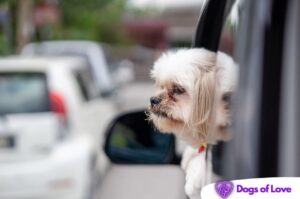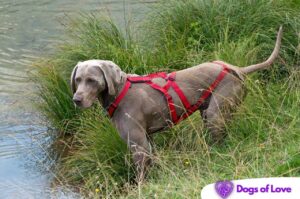Welcome to a discussion addressing a critical concern of responsible pet owners: ensuring the safety and well-being of their beloved canine companions during car travels.
Just as we prioritize our safety by wearing seat belts, the same consideration should extend to our four-legged friends.
The question at hand is a crucial one: Should you buckle your dog in the car?
As we delve into this topic, we will explore why securing your dog in the car is essential.
We will discuss the potential risks associated with leaving them unsecured, as well as the available safety measures to keep both your dog and other passengers safe on the road.
Let’s navigate through the information and guidelines that will help you make an informed and responsible decision regarding your furry friend’s safety during car journeys.

What are the Benefits of Buckling Up Your Dog While Driving?
Buckling up your dog while driving offers several crucial benefits for both the safety of your pet and the overall security of everyone in the vehicle.
Firstly, it restrains your dog and prevents them from moving around the car, minimizing distractions to the driver and reducing the risk of accidents.
Secondly, in the unfortunate event of a sudden stop or collision, a properly secured dog is less likely to become a projectile that can cause harm to themselves or others.
Additionally, it protects your furry companion, ensuring they are less likely to be injured or thrown from the vehicle in the event of a crash.
Ultimately, investing in a dog seat belt or a secured crate for your pet demonstrates responsible pet ownership and promotes a safer and more controlled driving experience.
How to Locate the Best Seat Belt for Your Dog?
Finding the best seat belt for your dog involves considering several key factors.
Firstly, assess your dog’s size, weight, and breed to determine the appropriate size and strength of the harness size needed.
Measure your dog’s girth and neck to ensure a comfortable fit without being too tight or too loose.
Look for seat belts that are adjustable, durable, and made from high-quality materials to guarantee both safety and comfort for your pet.
It’s essential to choose a product that has been crash-tested and approved for use in vehicles to provide the highest level of protection in case of an accident.
Additionally, read reviews and seek recommendations from trusted sources or veterinarians to ensure you select a seat belt that suits your dog’s specific needs and keeps them secure while traveling.
What About Other Forms of Restraint?
When it comes to ensuring the safety of your furry companion during car rides, alternative forms of restraint, such as car seats and soft crates, can also be effective options.
Car seats designed for dogs are handy for smaller breeds, providing them with a secure and elevated position that enables them to see outside while keeping them confined.
These seats often have straps or harnesses to keep the dog in place.
On the other hand, soft crates offer a portable and enclosed space for your dog, ensuring they stay in one place during the journey.
Soft crates are especially suitable for calm and well-trained dogs, offering a comfortable and familiar environment.
Ultimately, the choice of restraint will depend on your dog’s size, behavior, and preferences, as well as the type of travel and your vehicle’s layout.
What are the Tips for Keeping Your Dog Safe and Comfortable on a Road Trip?
Ensuring your dog’s safety and comfort during a road trip is paramount for a successful and enjoyable journey.
First and foremost, secure your dog with an appropriate restraint, such as a seat belt, harness, car seat, or crate, to prevent unnecessary movement and potential injuries.
Plan regular stops for bathroom breaks, stretching, and hydration, allowing your dog to relieve themselves and stay comfortable.
Pack essential supplies, including food, water, bowls, medications, familiar toys, and a comfortable blanket to provide a sense of home.
Maintain a comfortable temperature within the vehicle, ensuring it’s neither too hot nor too cold for your dog.
Prioritize their well-being by keeping them well-fed, providing regular exercise at rest stops, and giving them the attention and care they need throughout the journey.
Examples of States with Laws Requiring Dog Restraints in Cars
Several states in the USA have enacted laws mandating the restraint of dogs in vehicles to enhance safety during travel.
In New Jersey, for instance, pets must be secured in a carrier or wear a seat belt while the vehicle is in motion.
Rhode Island, Arizona, Connecticut, Iowa, Maine, Massachusetts, and South Carolina have also implemented similar regulations, emphasizing the importance of restraining pets to prevent distractions and ensure the well-being of both the animals and the passengers.
Violations of these laws could result in fines or penalties.
It’s important to note that laws and regulations can change over time, so it’s advisable to check the most current laws in your specific state before traveling with your dog.
A Look at Motor Vehicle Accidents Involving Dogs Without Restraints
In a collision, unrestrained dogs can become projectiles, posing a danger to themselves, other passengers, and pedestrians.
The impact of an accident can cause severe injuries or fatalities to the dog, as well as to human occupants, due to the uncontrolled movement and force exerted within the vehicle.
Additionally, unrestrained dogs may escape or get lost during or after an accident, adding emotional distress to an already challenging situation.
Overall, it is imperative to restrain dogs properly while traveling to mitigate these risks and ensure the safety and well-being of everyone on the road.
In conclusion
Buckling your dog in the car is a responsible and safety-conscious choice with numerous benefits.
Restraining your dog during car travel not only prevents distractions to the driver, reducing the likelihood of accidents, but it also safeguards your furry companion from potential injuries in case of sudden stops or collisions.
Moreover, using a seat belt, harness, car seat, or crate for your dog portrays responsible pet ownership and enhances overall safety during travel.
Prioritizing your dog’s safety and comfort ensures a smoother and more secure journey, benefiting your beloved pet and everyone sharing the road.
So, the answer is clear: Yes, you should buckle your dog in the car for a safer and more enjoyable travel experience.








